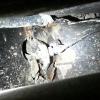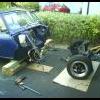
Welding A Fuel Tank
#1

Posted 26 April 2013 - 05:14 PM
#2

Posted 26 April 2013 - 05:28 PM
#3

Posted 26 April 2013 - 05:32 PM
#4

Posted 26 April 2013 - 05:34 PM
Dan
#5

Posted 26 April 2013 - 05:39 PM
#6

Posted 26 April 2013 - 05:39 PM
#7

Posted 26 April 2013 - 05:52 PM
Fast forward to 2011
My dad buys a series 2 Land Rover, 1958, which hadnt been on the road since 1980.At some time in the years since, the petrol tank had rotted through along the back edge due to water sat in the bottom for all those years. So he filled it with water to purge it, then with it on the bench, he lit the gas torch ready to braze up the holes. The tank blew like a gun going off, luckily the filler pipe was facing away from him so it only hurt our ear drums. This would have cleared any fumes left in the tank. Not so. It did it again, this time with the outlet pipe facing him, the flash melted his man-made fibre clothes to his chest, thankfully he was using his automatic mig mask so his face was spared, but the flash destroyed the solar panel and sensor on the mask. My dad spent 2 weeks in the burns unit at Preston hospital.
I probably spent more in car parking fees visiting him than a new tank would have cost.
I'm not one for worrying about health and safety, I've got by on my own wits for too long to let some rule writer tell me how or what to do, but it scared the living **** out of me, and I wouldnt go near a used tank with a welder again. We put this down to the old petrol evaporating but leaving some sort of residue in the tank. Maybe if you washed the tank out with some strong detergent or degreaser, it would help?
Stu
#8

Posted 26 April 2013 - 06:09 PM
yep, thats the trade accepted method.
#9

Posted 27 April 2013 - 01:14 PM
#10

Posted 27 April 2013 - 02:00 PM
Wash it out with in inflammable degreaser, then leave in the sun for a day or two. Light the end of a long stick and pick it in to be sure.
#11

Posted 27 April 2013 - 03:23 PM
A colleague used to use this method (but I haven't seen/tried it myself)... Clean the tank out as best you can then connect the hose of a steam wallpaper stripper to the filler neck to run steam through it while it is being welded. Because the tank is filled with steam then there should be no way that residual vapours can flash.
HOWEVER (disclaimer!) - welding anywhere near flammable fumes would scare the sh!t out of me so best get this done by a professional!
#12

Posted 30 April 2013 - 12:31 PM
But in any case it needs to be tested, using the proper hydrocarbon detection equipment, before it can be said to be safe.
The other way is to fill it COMPLETELY with dry sand, which will not impair the welding process but will prevent explosion, but I guess that none of you will have any confidence in your ability to remove all the sand afterwards, and you certainly don't want it in the engine! An expensive substitute for the sand, which will still prevent explosion, is special flakes of silicone rubber, which will be easier to clean out afterwards.
Remember that people who are welding tanks professionally MUST comply with the Health and Safety at Work Act and all its dependent legislation, and are well within their rights to refuse to touch a used tank.
#13

Posted 30 April 2013 - 01:13 PM
don't try this at home kids :)
1 user(s) are reading this topic
0 members, 1 guests, 0 anonymous users


















